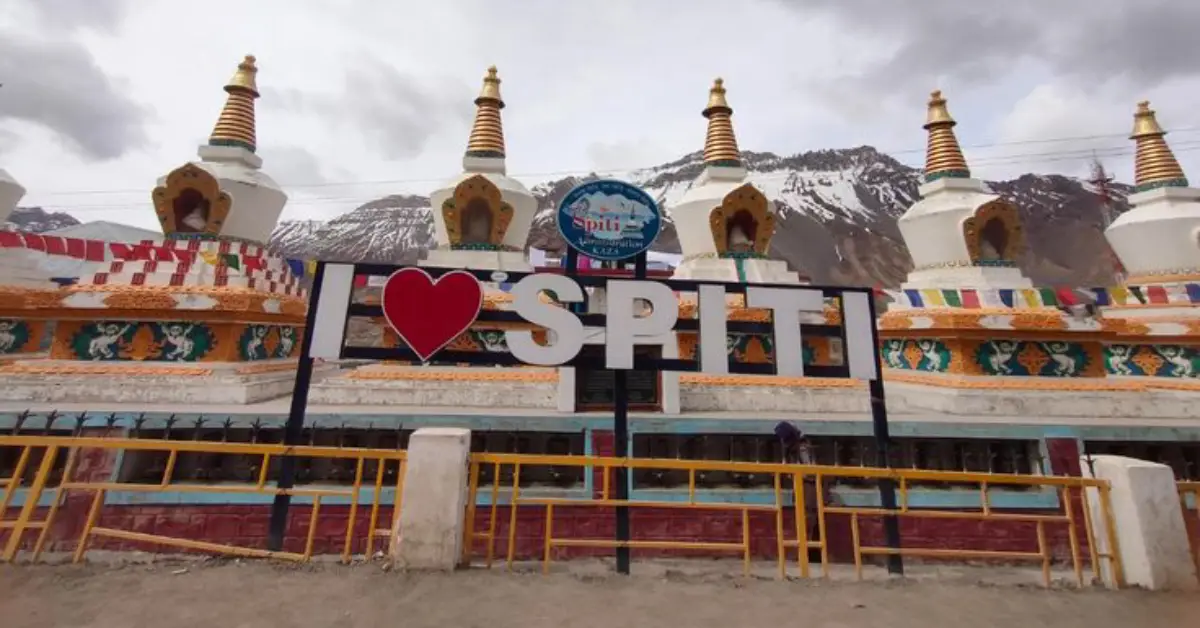Nestled high in the Himalayas of Himachal Pradesh, Spiti Valley remains one of India’s most breathtaking yet lesser-explored destinations. Often referred to as “Little Tibet” or “The Middle Land” (between India and Tibet), this cold desert mountain valley offers landscapes so surreal that they seem to belong to another planet altogether. With its pristine beauty, ancient Buddhist monasteries, and unique culture, Spiti Valley presents an experience that stays with travelers long after they’ve returned to the lowlands.
A Land of Stark Beauty

Spiti Valley sits at an average altitude of 12,500 feet above sea level, surrounded by towering snow-capped mountains. The landscape here is characterized by its barren, rugged terrain, deep gorges carved by the Spiti River, and dramatic rock formations that showcase millions of years of geological history. The valley’s name itself means “The Middle Land” – a fitting description for this region that exists between the lush greenery of Kullu Valley and the high-altitude desert of Ladakh.
What makes Spiti truly unique is its stark, moonlike landscape. The mountains here display a palette of browns, grays, and occasional whites, creating a canvas that changes colors with the shifting sunlight throughout the day. During summer, tiny patches of green cultivation around villages provide a stunning contrast to the otherwise barren terrain. In winter, the entire valley transforms into a snow-covered wonderland, inaccessible to most visitors due to heavy snowfall blocking the mountain passes.
Buddhist Heritage and Ancient Monasteries
Spiti Valley is home to some of the oldest and most important Buddhist monasteries in the world. These monastic complexes, perched precariously on hilltops or built into mountain faces, have been centers of Buddhist learning and culture for over a thousand years.
Key Monasteries Worth Visiting:
1. Key Monastery (Ki Monastery): The iconic symbol of Spiti Valley, this monastery dates back to the 11th century and sits atop a hill at an altitude of 13,668 feet. Built in the Pasada style, resembling a fortress, Key Monastery houses rare Buddhist scriptures, ancient murals, and a collection of weapons. The panoramic views of the valley from here are nothing short of spectacular.
2. Tabo Monastery: Founded in 996 CE, Tabo is often called the “Ajanta of the Himalayas” due to its exquisite murals and stucco sculptures. This UNESCO World Heritage Site is the oldest continuously functioning Buddhist enclave in India and the Himalayas, containing nine temples, numerous stupas, and monks’ chambers.
3. Dhankar Monastery: Perched dramatically on a cliff overlooking the confluence of the Spiti and Pin rivers, Dhankar was once the capital of Spiti Kingdom. The 1,200-year-old structure seems to merge with the rocky outcrop it’s built upon, creating a breathtaking sight. The monastery houses a statue of Vairochana (the Buddha of Light) consisting of four complete Buddha figures seated back-to-back.
4. Lhalung Monastery: One of the earliest monasteries founded by the great Tibetan Buddhist lotsawa (translator) Rinchen Zangpo, Lhalung is located in what is considered one of the most beautiful villages in Spiti. The monastery houses a large golden Buddha statue and walls adorned with numerous small Buddha images.
Villages Frozen in Time
The villages of Spiti Valley offer a glimpse into a way of life that has remained largely unchanged for centuries. The traditional whitewashed mud houses with flat roofs sit in perfect harmony with the surrounding landscape, designed to withstand the harsh mountain climate.
Hikkim: Home to the world’s highest post office at 14,567 feet, this tiny village allows visitors to send postcards from a truly unique location.
Komic: Often claimed to be the highest motorable village in the world connected by a road (though this is contested), Komic sits at an altitude of around 15,000 feet and houses a small monastery.
Langza: Known for its large Buddha statue overlooking the village and the surrounding mountains, Langza is also famous for marine fossils found in the region, evidence that this high-altitude desert was once under the Tethys Sea.
Demul: This traditional village offers a glimpse into authentic Spitian life, with opportunities for homestays where visitors can experience local cuisine and daily routines.
The Spitian Way of Life
Life in Spiti is defined by adaptation to extreme conditions. Winters here are severe, with temperatures dropping to -30°C (-22°F), and the region remains cut off from the rest of the world for months. The locals have developed unique customs and practices to survive in this challenging environment.
Agriculture in Spiti is limited to a short growing season, with barley, black peas, and potatoes being the main crops. Traditional houses are built with thick mud walls and small windows to retain heat. Solar energy is widely used, taking advantage of the abundant sunshine in this high-altitude desert.
The people of Spiti follow Tibetan Buddhism, and religion plays a central role in their daily lives. Prayer flags flutter in the mountain breeze, and prayer wheels are a common sight in villages. The local dialect, Bhoti, is similar to Tibetan, reflecting the region’s cultural ties with Tibet.
Wildlife in the Cold Desert
Despite its harsh conditions, Spiti Valley is home to remarkable wildlife. The Spiti Valley Wildlife Sanctuary and parts of the Pin Valley National Park protect several endangered species.
The elusive snow leopard roams the higher reaches of these mountains, while the Himalayan ibex, blue sheep (bharal), red fox, and Tibetan wolf are other notable mammals found here. The region also hosts unique bird species like the Himalayan griffon vulture, golden eagle, and Himalayan snowcock.
Best Time to Visit
Spiti Valley is accessible by road from two directions – from Manali via Rohtang Pass and Kunzum Pass, or from Shimla via Kinnaur Valley. The Manali route is only open during summer (June to October), while the Kinnaur route remains open for most of the year except during heavy snowfall.
The best time to visit Spiti Valley is during the summer months from June to September when the weather is relatively pleasant with daytime temperatures ranging from 15°C to 25°C (59°F to 77°F). This period also coincides with local festivals and cultural events.
Winter in Spiti (November to May) offers a completely different experience, with the landscape transformed by snow. However, visits during this time require careful planning due to extreme cold and limited accessibility.
Responsible Tourism in a Fragile Ecosystem
The fragile ecosystem of Spiti Valley demands responsible tourism practices. The region faces challenges related to waste management, limited water resources, and maintaining its unique cultural identity in the face of increasing tourism.
Visitors are encouraged to respect local customs, minimize plastic usage, conserve water, and support community-based tourism initiatives. Many villages now offer homestay experiences, providing an opportunity for cultural exchange while ensuring tourism benefits the local economy directly.
Adventure Activities
For adventure enthusiasts, Spiti offers numerous activities:
Trekking: Popular treks include the Pin Parvati Pass trek, Hampta Pass trek, and the Parang La trek, offering stunning views and challenging terrain.
Mountain Biking: The rugged roads of Spiti provide excellent, if challenging, mountain biking opportunities.
River Rafting: The Spiti River offers white-water rafting experiences during the summer months.
Fossil Hunting: The Langza region is known for marine fossils dating back millions of years.
Spitian Cuisine
The cuisine of Spiti is influenced by Tibetan and Himalayan food traditions. Some must-try local dishes include:
- Thukpa: A nourishing noodle soup with vegetables and sometimes meat
- Momos: Steamed dumplings filled with vegetables or meat
- Butter Tea: A traditional tea made with yak butter and salt
- Chang: A mild alcoholic beverage made from fermented barley
Practical Information for Travelers
Accommodation: Options range from monasteries offering basic rooms to homestays, guesthouses, and a few hotels in larger settlements like Kaza (the administrative center of Spiti).
Connectivity: Mobile network coverage is limited, with only BSNL working in some areas. Wi-Fi is available in some hotels in Kaza but is generally unreliable.
Altitude Sickness: Due to the high altitude, visitors should allow time for acclimatization and be aware of symptoms of altitude sickness.
Permits: Indian nationals don’t need permits to visit Spiti Valley. Foreign nationals require an Inner Line Permit for certain areas.
Conclusion
Spiti Valley offers a journey not just through magnificent landscapes but also through time. It’s a place where ancient Buddhist traditions continue to thrive, where villages exist in harmony with nature’s extremes, and where the night sky reveals stars in a clarity rarely seen elsewhere.
For travelers seeking an experience off the beaten path, Spiti provides a profound connection with nature, culture, and spirituality. The journey may be challenging, with rough roads and basic amenities, but the rewards are immeasurable – breathtaking vistas, cultural insights, and moments of tranquility that remain etched in memory long after the journey ends.
As the Spiti River continues to carve its path through the mountains, this hidden Himalayan valley awaits those willing to venture beyond the ordinary, offering a glimpse into a world where time moves at its own pace and the connection between people and nature remains unbroken.




